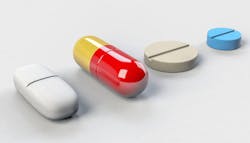People & Opinions
In February, new laws went into effect across the European Union to address the safety of medicines and related products. As part of the Falsified Medicines Directive an anti-tampering device and a unique identifier in the form of a 2D barcode will be required for all new prescription medicines in the EU. These efforts are designed to simultaneously make these medicines more easily recognized as the genuine product as well as make it more difficult to falsify or replace the contents of any prescription drug or its container. The directive stems from years of research and strategy designed to address the safety and security of medicines.
In our everyday lives, we tend not to think about the risks associated with getting the wrong medicines. We don’t imagine that there are people out there tampering with ingredients or intercepting real and potent medications, only to replace them with less powerful or sometimes dangerous look-alikes. But this is exactly what happens. In fact, according to the World Health Organization (WHO), over 10% of global sales for pharmaceuticals are for counterfeit drugs.1
If that’s not enough to leave an impression, this is: TENS OF THOUSANDS OF PEOPLE DIE each year as a result of taking fake medications.2 Countless others are injured—or at the very least, not helped in the manner the drug they are prescribed is intended to help. Imagine your mother, your child, yourself…
Why address fake medicines?
- Patient Safety. There’s an obvious patient safety concern. The wrong dose could have significant detrimental impact. Then, there’s the issue of the unknown. Who knows what these counterfeit medicines are being mixed with? The potential for drug interactions, allergic reactions—or a patient simply not receiving much-needed medications are all major concerns.
- Access. The Internet has made it far easier for people to acquire medicines outside the historical norm: your local pharmacy. With this comes a lack of oversight and assurance from a reputable source.
- Awareness. Implementing standards for unique identification and tamper resistance not only makes it easier to recognize false medicines, it makes it easier to educate patients and their families as to what to expect in legal, authorized medicines. In this way, patients play a role in their own safety.
- Money. The pharmaceutical industry in the U.S. alone is estimated to have lost $46 Billion to counterfeit medications. Perhaps there’s the impression that pharmaceutical companies are getting their due—but, remember—people are dying. And every penny spent on black market drugs takes away from the 20 percent pharmaceutical companies invest in research and development.
- Oversight. Providing a unique identifier on all authorized, legal drugs will enable full-circle supply chain reporting from pharmaceutical production to the patient. Ultimately, the EU will have comprehensive data not just from the supply chain and utilization, but also patient outcomes. There will be no better or easier way to measure success.
In addition to the anti-tamper and unique identification elements, the EU created an online reporting system to allow pharmaceutical companies to report if any known or suspected counterfeits of the drugs they produce. (Presumably, this information would then be communicated to hospitals and pharmacies.) For my own part, I’m surprised this isn’t expanded minimally to physicians and pharmacists for reporting, but suspect that day may come.
What does this mean for the United States, and the world?
The truth is—counterfeit medications are not a huge threat in developed countries. While the figure above is 10% globally, in the U.S., counterfeit drugs appear less than 1percent of the time—maybe one pill pack in every 20,000 scanned will be fake. Compare that to developing countries where three (3) out of every 10 medications purchased are counterfeit. Considering the pharmaceutical supply chain originates in developed countries, it’s our responsibility to ensure the safety and security of the medicines we produce, and that there are systems put in place to safeguard consumers worldwide.
Creating a digital closed-loop supply chain for pharmaceuticals is absolutely necessary, and the US should be right alongside the EU in leading this effort. The results would have far greater impact globally than we can even begin to assess.
The U.S. (through the FDA) has taken several steps to help physicians and pharmacists as well as consumers identify legitimate and counterfeit drugs. Its efforts primarily rely on healthcare professionals and consumers to recognize bad behaviors, mislabeled drugs, variation from pack-to-pack and too-good-to-be-true scams. There’s little in the way of assurance—especially as the market to purchase medications is more open in the United States.
On February 7, two days before the EU’s new regulations went into effect, the FDA announced a new program to “pilot the use of innovative and emerging approaches for enhanced tracing and verification of prescription drugs in the U.S. to ensure suspect and illegitimate products do not enter the supply chain.” The track-and-trace program was set to run from February 8 to March 11, 2019, but not go into effect until 2023. As yet, I have not seen any news on the outcomes of this program and if the US intends to pursue further unique identification or track-and-trace programs to support global safety.
But, it should.
In the meantime, the FDA has applied for registration under the EU’s Falsified Medicines Directive. Under the Drug Quality Security Act (DQSA), the US has similar unique identifier requirements, but less clear standards on tamper resistance. My hope is, if accepted, it would mean that all drugs being imported to the EU under the FDA would need to meet the EU’s more stringent requirements. In turn, any drugs coming in from the EU would already be certified safe.
References
About the Author

Noel O’Hanlon
Noel O’Hanlon is Founder and CEO, Genesis Automation in Healthcare. For over 30 years, O’Hanlon has focused on high-tech software automation solutions, and for the last 10, bringing this technology to hospitals and medical device manufacturers. In less than 10 years’ time, he’s grown Genesis Automation, a clinical supply chain automation business from Cork, Ireland to one of international success—by focusing on what clients truly care about: delivering safe, effective care as efficiently as possible.
